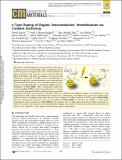Files in this item
n-type doping of organic semiconductors : immobilization via covalent anchoring
Item metadata
| dc.contributor.author | Reiser, Patrick | |
| dc.contributor.author | Benneckendorf, Frank S. | |
| dc.contributor.author | Barf, Marc-Michael | |
| dc.contributor.author | Müller, Lars | |
| dc.contributor.author | Bäuerle, Rainer | |
| dc.contributor.author | Hillebrandt, Sabina | |
| dc.contributor.author | Beck, Sebastian | |
| dc.contributor.author | Lovrincic, Robert | |
| dc.contributor.author | Mankel, Eric | |
| dc.contributor.author | Freudenberg, Jan | |
| dc.contributor.author | Jänsch, Daniel | |
| dc.contributor.author | Kowalsky, Wolfgang | |
| dc.contributor.author | Pucci, Annemarie | |
| dc.contributor.author | Jaegermann, Wolfram | |
| dc.contributor.author | Bunz, Uwe H. F. | |
| dc.contributor.author | Müllen, Klaus | |
| dc.date.accessioned | 2019-07-02T16:30:03Z | |
| dc.date.available | 2019-07-02T16:30:03Z | |
| dc.date.issued | 2019-06-11 | |
| dc.identifier | 259453254 | |
| dc.identifier | 6a79e9cc-dcb4-420c-9b57-45bc339908ac | |
| dc.identifier | 85066493769 | |
| dc.identifier | 000471728200039 | |
| dc.identifier.citation | Reiser , P , Benneckendorf , F S , Barf , M-M , Müller , L , Bäuerle , R , Hillebrandt , S , Beck , S , Lovrincic , R , Mankel , E , Freudenberg , J , Jänsch , D , Kowalsky , W , Pucci , A , Jaegermann , W , Bunz , U H F & Müllen , K 2019 , ' n-type doping of organic semiconductors : immobilization via covalent anchoring ' , Chemistry of Materials , vol. 31 , no. 11 , pp. 4213-4221 . https://doi.org/10.1021/acs.chemmater.9b01150 | en |
| dc.identifier.issn | 0897-4756 | |
| dc.identifier.other | RIS: urn:8083857F8B682A73E1B3885C4D28F80E | |
| dc.identifier.uri | https://hdl.handle.net/10023/18023 | |
| dc.description | We gratefully acknowledge the German Federal Ministry of Education and Research (BMBF) for financial support within the InterPhase project (FKZ 13N13659, 13N13656, 13N13657, and 13N13658). | en |
| dc.description.abstract | Electrical doping is an important tool in the design of organic devices to modify charge carrier concentration in and Fermi level position of organic layers. The undesired diffusion of dopant molecules within common transport materials adversely affects both lifetime and device performance. To overcome this drawback, we developed a strategy to achieve immobilization of dopants through their covalent attachment to the semiconductor host molecules. Derivatization of the commonly employed n-type dopant 2-(2-methoxyphenyl)-1,3-dimethyl-2,3-dihydro-1H-benzoimidazole (ο-MeO-DMBI) with a phenylazide enables the resulting o-AzBnO-DMBI to photochemically generate a reactive nitrene, which subsequently binds covalently to the host material, 6,6-phenyl-C61-butyric acid methyl ester (PCBM). Both the activation and addition reactions are monitored by mass spectrometry as well as optical and photoelectron spectroscopy. A suppression of desorption and a decrease in volatility of the DMBI derivative in ultrahigh vacuum were observed after activation of a bilayer structure of PCBM and o-AzBnO-DMBI. Electrical measurements demonstrate that the immobilized o-AzBnO-DMBI can (i) dope the PCBM at conductivities comparable to values reported for o-MeO-DMBI in the literature and (ii) yield improved electrical stability measured in a lateral two terminal device geometry. Our immobilization strategy is not limited to the specific system presented herein but should also be applicable to other organic semiconductor–dopant combinations. | |
| dc.format.extent | 9 | |
| dc.format.extent | 1934172 | |
| dc.language.iso | eng | |
| dc.relation.ispartof | Chemistry of Materials | en |
| dc.subject | QC Physics | en |
| dc.subject | NDAS | en |
| dc.subject.lcc | QC | en |
| dc.title | n-type doping of organic semiconductors : immobilization via covalent anchoring | en |
| dc.type | Journal article | en |
| dc.contributor.institution | University of St Andrews. School of Physics and Astronomy | en |
| dc.identifier.doi | https://doi.org/10.1021/acs.chemmater.9b01150 | |
| dc.description.status | Peer reviewed | en |
This item appears in the following Collection(s)
Items in the St Andrews Research Repository are protected by copyright, with all rights reserved, unless otherwise indicated.

